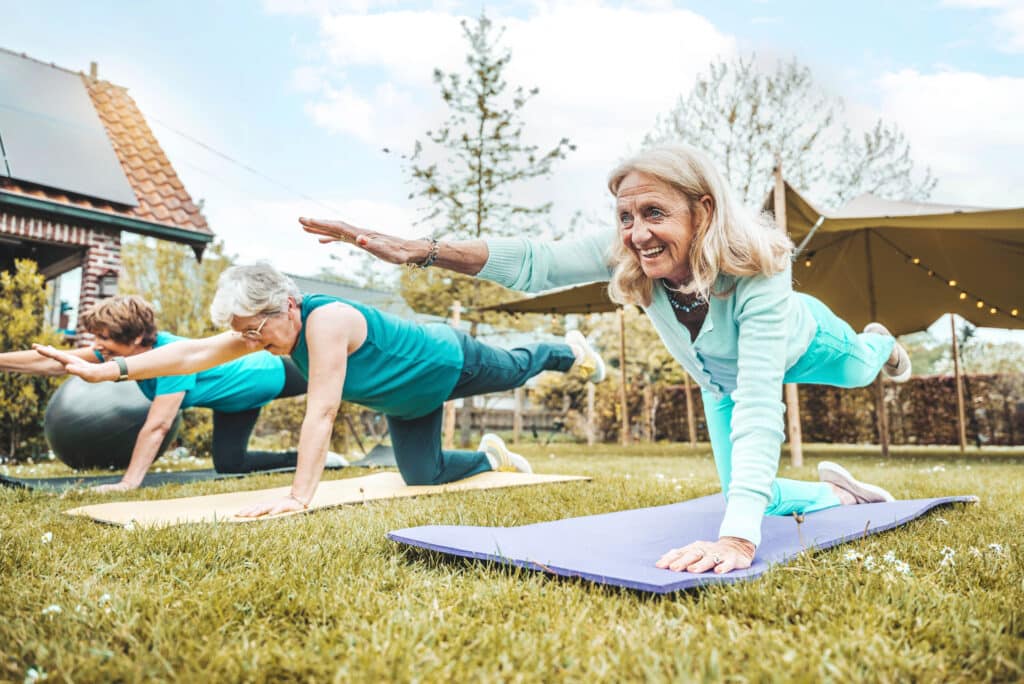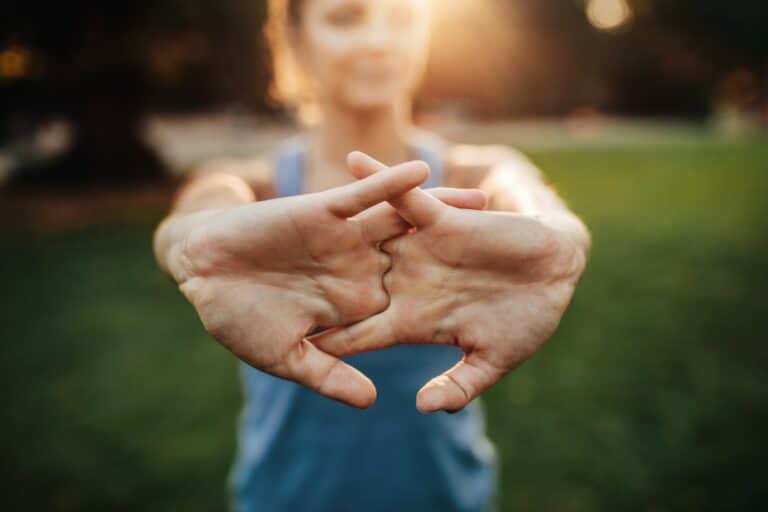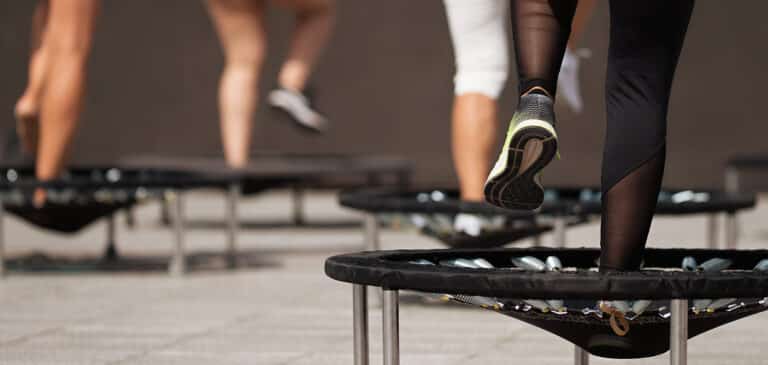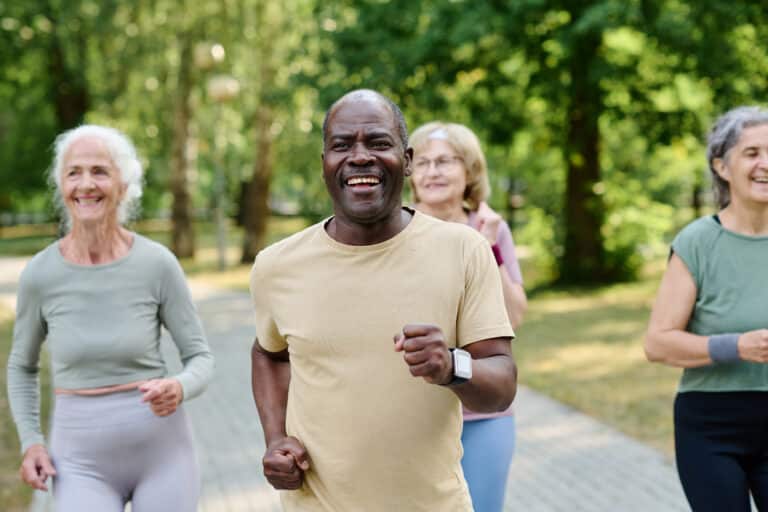How often do you think about your core muscles? If you’re like most seniors, you pay little attention to them until problems like poor posture, pain, or balance issues arise. Thankfully, simple core exercises are a great way to improve your general health and quality of life as you age.
Your core muscles are the foundation of your body. They support your spine to help you move better, reduce pain, and enhance your performance in your regular activities.
This article will teach you to perform core exercises safely and effectively. I will also explain the anatomy and function of the core muscles, common core-related challenges, and how to plan for a core workout.
By the end of this article, you will better understand what core exercises are, why they benefit seniors like you, and how to create a core exercise routine that suits your lifestyle needs.
The Value of Core Exercises for Seniors

Core exercises target and strengthen the muscles surrounding and supporting your spine, pelvis, and trunk. They include your abdominal muscles, back muscles, pelvic floor muscles, and diaphragm, which all work together to stabilize your upper body and help you move more efficiently.
In my experience, older adults with good strength and endurance in their core muscles are much healthier with fewer injuries. Here are some of the benefits of core exercises for seniors (1, 2):
Improved balance: Your core muscles help you maintain your center of gravity and remain upright. A strong core can help you prevent falls and injuries, which are too common among seniors. Core exercises can also improve your coordination and reaction time, which can help you avoid tripping or stumbling.
Improved posture: Your core muscles help you hold your spine and pelvis in a neutral position, and having a strong core can help you prevent or correct poor posture. Core exercises can also improve your confidence and self-esteem, making you look taller and more confident.
Improved mobility: Your core muscles help you bend, twist, and reach with more control. This means having a strong core can help you perform your daily activities more efficiently and comfortably. Having improved mobility can help you prevent stiffness and joint pain, which is a common problem for many of the seniors that I’ve worked with.
Prevent back pain: Your core muscles help you support and protect your spine from excessive stress and strain. With this in mind, it makes sense that a strong core can help you prevent or reduce lower back pain. Additionally, core exercises can help prevent or delay degenerative conditions such as osteoporosis or arthritis.
Core exercises are essential for seniors who want to improve their health and wellness as they age. Still, not all core exercises are suitable for seniors. To better understand why, let’s talk about the anatomy and function of the core in more detail.
The Anatomy & Function of the Core Muscles
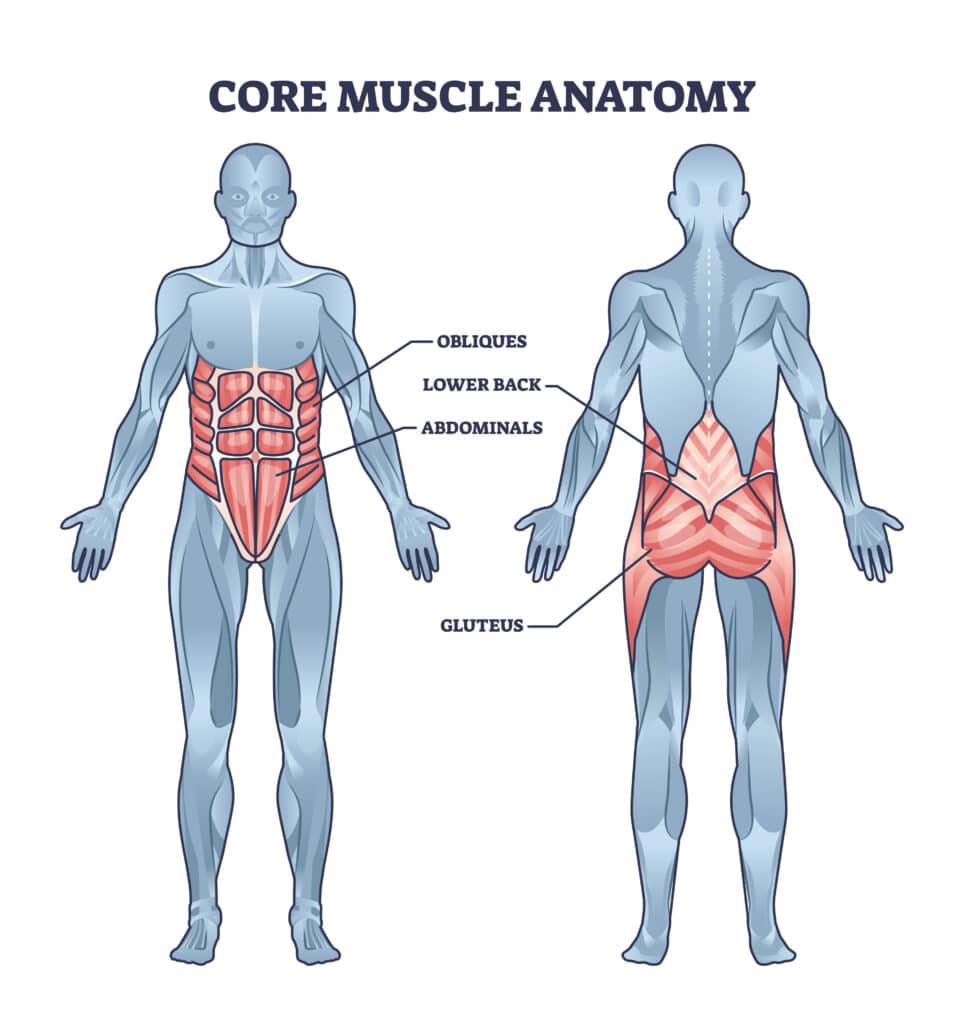
The core muscles can be divided into two muscle groups: the deep core muscles and the superficial core muscles.
Your deep core muscles are the innermost layer of muscles that attach directly to your spine and pelvis, which are responsible for providing stability and support to your spine and pelvis.
Your superficial core muscles are the outer layer of muscles that attach to your ribs, hips, and limbs – responsible for providing movement and power to your body.
The Primary Core Muscles
The Rectus Abdominis—what most people call “abs”—is the most superficial abdominal muscle that runs from your breastbone to the front of your pelvis. This long muscle helps you flex your spine and tilt your pelvis. Although it is the focus of many abdominal workouts, it’s only one component of having a strong core.
The Transversus abdominis is the deepest abdominal muscle that wraps around your waist like a corset. It helps you compress your abdomen and stabilize your spine and pelvis.
The Multifidus is a group of small muscles that run along your spine from your neck to your tailbone. These help you extend, rotate, and stabilize your spine. While many don’t think of their back as part of their core, it’s one half of the equation!
The Pelvic floor is a group of muscles forming a hammock-like structure at the bottom of your pelvis. It helps you support your pelvic organs, control your bladder and bowel movements, and enhance your sexual function.
The Diaphragm is a dome-shaped muscle that separates your chest from your abdomen. It is the primary breathing muscle and contributes to spinal stability and posture.
The Internal and External Obliques are two pairs of abdominal muscles that run diagonally from your ribs to your hips. The oblique muscles help you rotate and side-bend your spine and generate power during everyday activities.
The Erector Spinae – This group of large muscles runs along your spine. They help you extend and side-bend your spine and are constantly active throughout your day to help maintain posture.
As you can see, the core muscles are complex and diverse. They play a vital role in maintaining your health and wellness as you age, which is why it’s important to strengthen them with core exercises that are safe and effective for seniors.
Common Core Problems and Challenges for Seniors
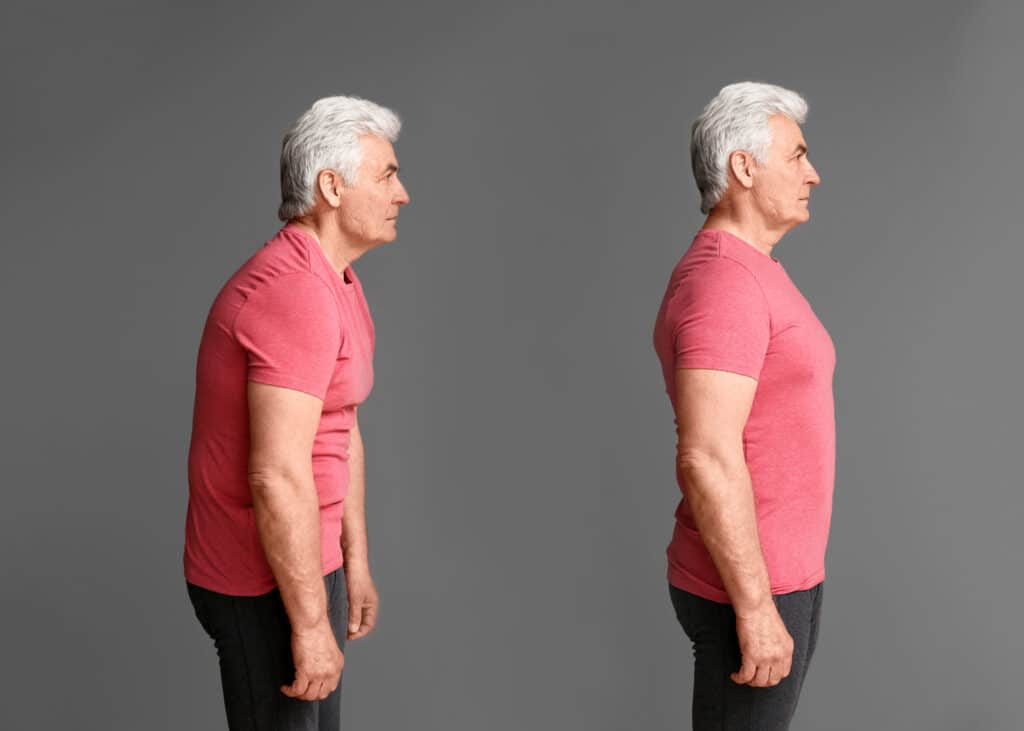
As you age, your core muscles weaken and lose their function. This can lead to various problems and challenges affecting your daily life and well-being.
Here are some of the common core problems and challenges that seniors face:
Poor posture
Posture depends on the strength and endurance of the muscles surrounding your spine. Ideally, your body should be stacked straight from your ears to the arches of your feet when viewed from the side. Unfortunately, this is not true for many older people who struggle with posture and core strength.
When your spine isn’t aligned correctly, it can cause increased stress from gravity, leading to rounded shoulders, slouching, or increased tilting of your pelvis.
Poor posture can result from weak core muscles, lack of flexibility, a sedentary lifestyle, or health conditions like arthritis. For many seniors, this can lead to problems like pain, headaches, and reduced confidence.
Back pain
Back pain is one of the most common complaints among the seniors that I work with. Back pain can sometimes result from weak core muscles, poor posture, lack of mobility, and excessive strain on your spine. Although back pain is rarely severe, it can limit your ability to move, perform daily activities, and enjoy everyday life.
Balance issues
Many seniors have difficulty maintaining their stability in different situations. While balance problems can result from inner ear conditions, vision problems, or certain medications, they can also result from weak core muscles.
Because falls are one of the leading causes of serious injury among seniors, having good core strength and balance is vital for maintaining long-term health.
Reduced mobility
Many older adults I work with have difficulty moving around or performing daily activities. Although this can be due to pain, fatigue, or disability, weak core muscles can also be a factor. Reduced mobility can limit your independence, quality of life, and health outcomes.
As you can see, core-related challenges are common among seniors and can negatively affect their quality of life. But there is hope! You can help minimize these challenges with core exercises that are safe and effective for seniors.
A Senior’s Guide to Performing Core Strengthening Exercises Safely
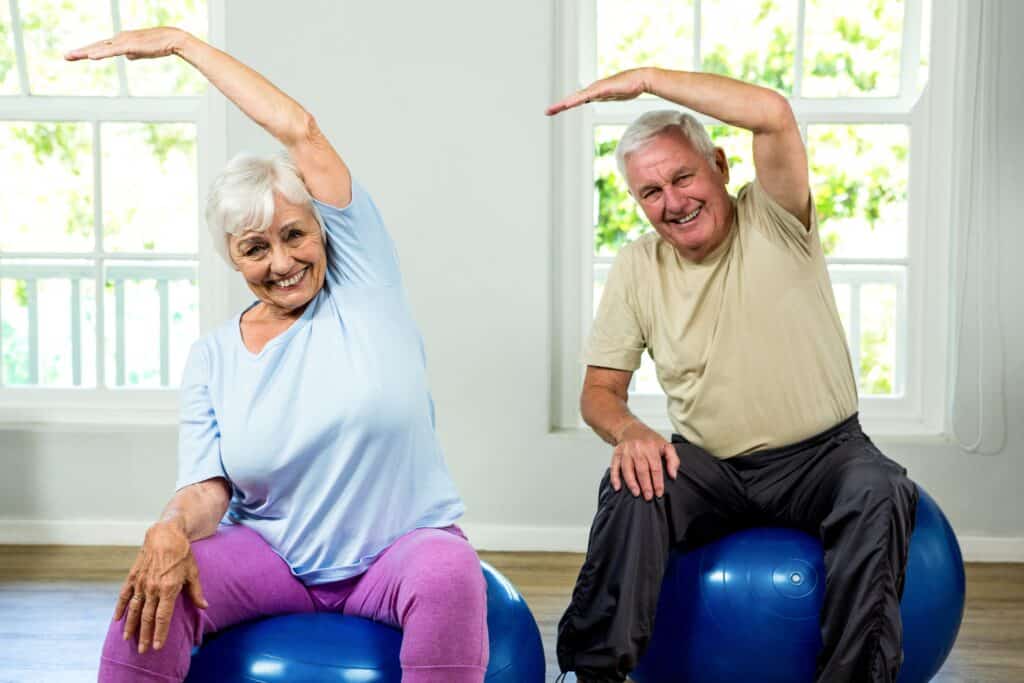
Core exercises can be beneficial and fun!
Before you start your new core exercise routine, there are some general tips and guidelines for performing core exercises:
Warming up
A good warm-up is essential to prepare your body and mind for exercise. It can help you improve your blood flow, lubricate your joints, and prevent injuries.
Warmups might include light cardio exercises such as walking, jogging, or cycling for 5 to 10 minutes. You can also do dynamic stretches, such as arm circles, leg swings, and trunk rotations.
Bracing your core
This is a method of core preparation intended to activate and strengthen your deep core muscles, such as the transversus abdominis and the multifidus. It can also help you stabilize and protect your spine to prevent injury during exercise.
To brace your core, gently draw your belly button toward your spine without sucking in or pushing out. Stay in this braced position throughout your exercise without losing it or bearing down.
Following a Gradual Progression
Pacing yourself is crucial to keep workouts challenging to improve your fitness level without overloading or injuring yourself. To progress gradually, start with easy exercises that suit your current ability and goals, then increase the difficulty of your exercises by performing more reps, sets, or weights.
Using equipment
Certain exercise equipment can help you enhance your core exercises by adding resistance, support, variety, or challenge. Commonly used equipment or accessories that can help with core exercises include mats, chairs, balls, and resistance bands.
Many seniors I work with find these tips helpful in performing core exercises safely and effectively. Remember, every person is different, so listening to your body and adjusting is essential. No single piece of equipment will be good for every body.
The Three Best Core Exercises for Seniors
Now that you know what core exercises are and why they are essential for seniors, it’s time to learn how to do a few. These exercises are safe and effective for seniors, and they can help you strengthen your core and improve your balance, posture, and mobility.
Here are some of the best core exercises for seniors recommended by a physical therapist:
Pelvic tilt
This simple but effective exercise targets your transversus abdominis and pelvic floor muscles. It helps you stabilize and control your pelvis and spine and improve your posture.
- Stand tall with your knees bent and your feet flat on the floor.
- Place your hands on your hips, relax your shoulders and neck, and inhale.
- As you exhale, gently draw your belly button toward your spine and tighten your pelvic floor muscles as if trying to stop urinating or passing gas. You should feel a slight movement of your pelvis toward your chest and a flattening of your lower back.
- Hold this position for a few seconds, then relax and return to the starting position.
Dead bug
This fun but challenging exercise targets your transversus abdominis, rectus abdominis, obliques, and multifidus muscles.
- Lie on a mat with your knees bent at 90 degrees and your feet off the floor.
- Raise your arms straight up toward the ceiling. As you inhale, brace your core and slowly lower your right arm and left leg toward the floor without touching the floor or changing the angle of your knee or elbow. Keep your lower back flat on the floor and avoid arching or rounding it.
- Pause briefly, then exhale and return to the starting position. Repeat with your opposite arm and leg.
If this exercise is too strenuous for you, you can start by lowering only one limb at a time, either your arm or your leg. You can also place a small pillow or towel under your lower back for extra support.
Bird dog
This challenging exercise targets your transversus abdominis, multifidus, glutes, and erector spinal muscles. It helps you balance and stabilize your spine and pelvis while moving your limbs in opposite directions.
- Start on your hands and knees on a mat, with your hands under your shoulders and your knees under your hips. Keep your back straight and avoid arching or rounding.
- As you exhale, brace your core and slowly extend your right arm and left leg straight out without touching the floor or losing your balance. Pause briefly, then return to the starting position.
- Repeat with your left arm and right leg.
If this exercise is too difficult, you can start by extending only one limb at a time, either your arm or your leg. You can also place a small pillow or towel under your knees or hands for extra comfort.
Performing these exercises regularly can help you strengthen your core and improve your balance, posture, and mobility. Talk with your physical therapist for more tips and core exercise ideas specific to your body and needs.
Key Takeaways
- Core exercises are crucial for seniors as they support the spine, aid movement, reduce pain, and boost daily performance. They improve balance, posture, and mobility and prevent back pain.
- The core muscles are complex and include both deep and superficial muscle groups, which provide stability, support, and power to the body. These encompass the abs, back, pelvic floor, and diaphragm.
- Aging can cause core muscles to weaken, leading to problems like poor posture, back pain, balance issues, and reduced mobility.
- To mitigate these challenges, seniors can incorporate safe and effective core exercises into their routines.
- Sessions should include a good warm-up, bracing the core, following a gradual progression, and using supportive equipment if needed.
- Understanding the individual’s ability and goals and listening to one’s body is critical when designing and following a core exercise routine.
FAQs
How often and for how long should seniors do core exercises?
The answer depends on your current fitness level and your goals.
For most seniors, core exercises can be done daily to see maximal results. It’s essential to listen to your body and take a rest day when the muscles of your core are sore or sensitive. Even if you can’t exercise daily, your body will eventually adapt to exercise more frequently with regular practice.
Why is focusing on core strength important for older people?
Core strength is crucial for the elderly as it supports the spine and helps maintain proper posture. It also assists in daily activities that require bending, twisting, and reaching. A strong core can help prevent or reduce lower back pain and delay degenerative conditions such as osteoporosis or arthritis.
How does the anatomy of the core contribute to balance, posture, and mobility?
The core muscles, including the deep and superficial core muscles, provide the body stability, movement, and power. They help maintain the body’s center of gravity, support the spine for good posture, and allow for controlled movements, all of which contribute to balance, posture, and mobility.
What is the role of equipment in enhancing core exercises for seniors?
Equipment like mats, chairs, balls, and resistance bands can add resistance, provide support, and introduce variety to core workouts, sometimes making them more effective.
References
Granacher, U., Gollhofer, A., Hortobágyi, T. et al. The Importance of Trunk Muscle Strength for Balance, Functional Performance, and Fall Prevention in Seniors: A Systematic Review. Sports Med 43, 627–641 (2013). https://doi.org/10.1007/s40279-013-0041-1
Jia, X., Jiang, C., Tao, J., Li, Y., Zhou, Y., & Chen, L. D. (2018). Effects of core strength training combined with Tai Chi Chuan for the musculoskeletal system and cardiopulmonary function in older adults: A study protocol for a randomized controlled trial. Medicine, 97(35), e12024. https://doi.org/10.1097/MD.0000000000012024

